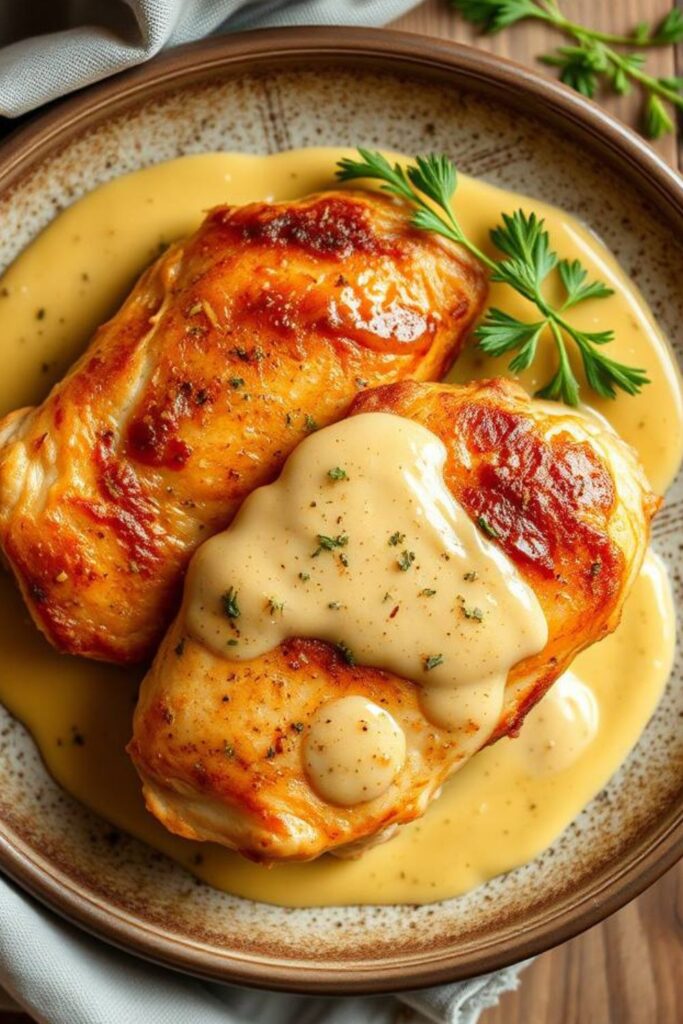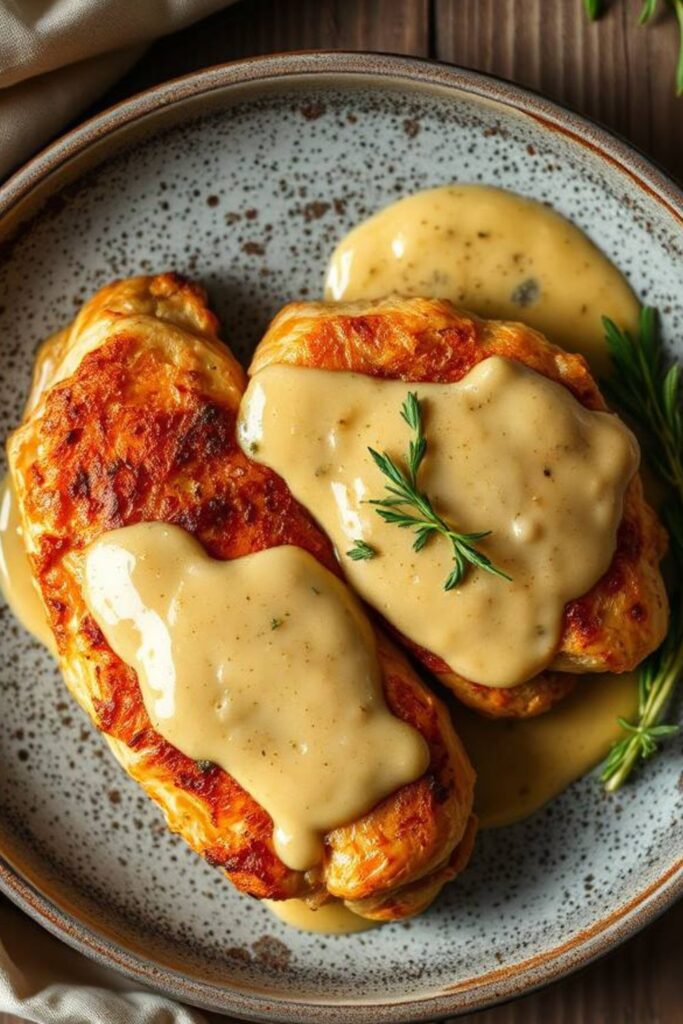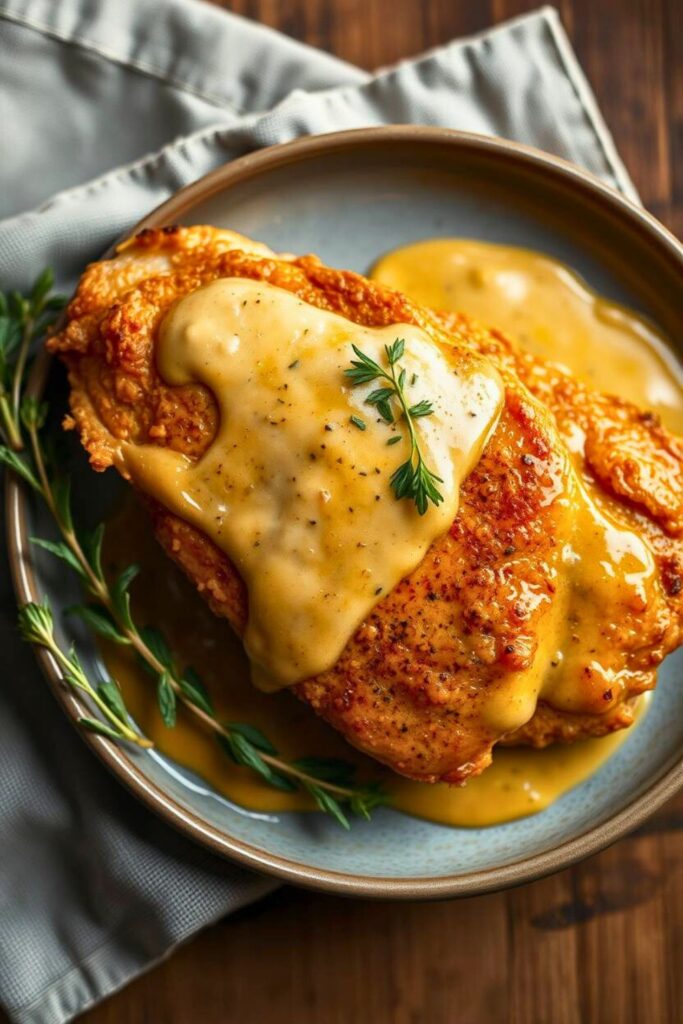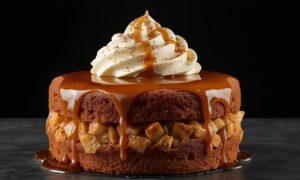Imagine standing in a bustling Paris bistro as the chef slides a golden crusted chicken breast across the pass. A silky Dijon cream sauce pools around tender vegetables. The aroma hits, sharp mustard, rich cream, and the earthy scent of herbs that evoke the French countryside. This is Chicken Dijonnaise: Classic French Flavour, and it’s about to become your secret weapon for turning any Tuesday night into something extraordinary.
Most people think French cooking is complicated, fussy, reserved for special occasions. Here’s the truth: Chicken Dijonnaise breaks every one of those rules. It’s elegant enough for date night, simple enough for weeknight dinner, and forgiving enough that even kitchen disasters can turn into triumphs. The magic isn’t in complexity; it’s in understanding how a few perfect ingredients transform into something that’ll make your neighbors suddenly very friendly.
This isn’t just another chicken recipe. It’s your gateway into understanding French technique, where every step builds flavor upon flavor until you’ve created something that tastes like it took hours but only demanded about thirty minutes of your time. Ready to make some culinary magic happen?
What Makes Chicken Dijonnaise Special
French cuisine gets intimidating press, but Chicken Dijonnaise proves that the best dishes come from simple principles executed brilliantly. This recipe embodies everything beautiful about French cooking respect for ingredients, technique that enhances rather than masks flavors, and that indefinable something that makes you close your eyes and sigh with the first bite.
The star here isn’t just chicken; it’s the interplay between protein and sauce. Dijon mustard brings complexity sharp, tangy, with subtle heat that awakens your palate without overwhelming it. Heavy cream smooths those edges, creating a sauce that’s both rich and bright. Fresh herbs add color and freshness, while a splash of white wine brings acidity that keeps everything balanced.
What sets this apart from other creamy chicken dishes? It’s all about the mustard. Dijon isn’t just flavoring it’s an emulsifier, helping create that silky sauce texture that coats the back of a spoon perfectly. Plus, that distinctive tang cuts through richness in a way that makes each bite as satisfying as the first.
The Cultural Story Behind the Sauce
Dijon mustard comes from Burgundy, where vineyard workers needed hearty, flavorful meals that could be prepared quickly after long days in the fields. This dish represents that practical elegance sophisticated flavors without precious techniques. It’s comfort food that happens to be incredibly refined.
The marriage of mustard and cream in French cooking goes back centuries. Chefs discovered that Dijon’s particular blend of mustard seeds and white wine creates sauces that are both stable and delicious. No broken emulsions, no curdling disasters just consistently gorgeous results.
Essential Ingredients for Perfect Chicken Dijonnaise

Main Players
Chicken breasts, (4 pieces, about 6 oz each) Go for organic if possible, but don’t stress if your budget says otherwise. The key is uniform thickness for even cooking.
Dijon mustard, (3-4 tablespoons) This is non negotiable. Regular yellow mustard won’t give you the same depth or emulsification properties. Grey Poupon works beautifully, but any quality Dijon will do.
Heavy cream (1 cup), No light cream, no half and half. We need that fat content for proper sauce texture.
Dry white wine (1/2 cup), Sauvignon Blanc or Pinot Grigio work perfectly. If you wouldn’t drink it, don’t cook with it.
Shallots (2 medium), More delicate than onions, they won’t overpower the mustard.
Fresh thyme (2 teaspoons), Dried works too, but fresh gives brighter flavor.
Butter (2 tablespoons), For richness and helping achieve that restaurant quality sauce finish.
Salt and white pepper, White pepper keeps the sauce looking clean and elegant.
Smart Swaps That Actually Work
Can’t find shallots? One medium yellow onion, diced fine, works just fine. You’ll lose some subtlety, but the dish still shines.
No white wine? Chicken broth with a squeeze of lemon juice gives similar acidity and depth. Don’t use cooking wine it’s loaded with salt and will throw off your seasoning.
Heavy cream substitute? Full fat coconut milk creates surprisingly good results, though the flavor profile shifts slightly tropical. For dairy free options, cashew cream blended smooth works too.
Fresh thyme missing? Dried thyme (1 teaspoon) or fresh tarragon (1 tablespoon) both complement Dijon beautifully. Avoid oregano or basil they’ll compete with the mustard.
Ingredient Selection Secrets
When choosing chicken, look for pieces that are similar in size and thickness. If they’re not, pound them gently between plastic wrap until they’re even. This prevents the dreaded scenario where some pieces are perfectly cooked while others are still pink or already dried out.
For Dijon mustard, read the ingredients. The best ones list mustard seeds, white wine, salt, and little else. Avoid anything with artificial flavors or excessive stabilizers they can interfere with sauce formation.
Your heavy cream should be as fresh as possible. Check the date, obviously, but also give it a smell. Fresh cream has almost no aroma if it smells sweet or slightly sour, pass on it.
Step by Step Chicken Dijonnaise Mastery
Prep Work That Pays Off
Start by getting your chicken to room temperature about 20 minutes on the counter does it. Cold chicken hits hot pan and seizes up, cooking unevenly and getting tough.
Season your chicken generously with salt and white pepper about 15 minutes before cooking. This isn’t just flavoring; it’s drawing out surface moisture so you get better browning. Pat them dry right before they hit the pan.
Dice your shallots fine think confetti size. Large pieces won’t cook evenly and might stay harsh and biting in the finished sauce.
The Searing Secret
Heat your pan over medium high heat until a drop of water sizzles and evaporates immediately. Add a tablespoon of neutral oil something that won’t compete with your flavors.
Place chicken smooth side down and resist every urge to move it. You’ll hear aggressive sizzling that’s good. We’re building a golden crust that’ll add incredible depth to the final dish. Give it 4-5 minutes, depending on thickness.
Flip once the edges look opaque about halfway up the sides. Cook another 3-4 minutes, then remove to a plate. Don’t worry if they’re not fully cooked they’ll finish in the sauce.
Building the Sauce Base
Reduce heat to medium and add your diced shallots to the same pan. All those brown bits from the chicken? That’s liquid gold. The shallots will help scrape them up while cooking.
Sauté until the shallots are translucent and fragrant about 2 minutes. Add your thyme and cook another 30 seconds until it smells amazing.
Pour in the white wine and let it bubble enthusiastically. This step burns off harsh alcohol while concentrating flavors. Cook until reduced by half you’ll see the liquid level drop noticeably.
The Cream and Mustard Magic
Lower heat to medium low before adding cream. Hot pans and cream can lead to curdling, and nobody wants lumpy sauce.
Whisk in the Dijon mustard gradually. Start with 2 tablespoons, taste, then add more if you want extra tang. The sauce should coat a spoon lightly but still flow easily.
Nestle your chicken back into the sauce. Cover and simmer gently for 8-10 minutes, until chicken reaches 165°F internal temperature. The gentle heat finishes cooking while infusing everything with flavor.
Final Flourishes
Remove from heat and swirl in cold butter. This technique, called mounting, gives restaurant quality gloss and richness to your sauce.
Taste and adjust seasoning. The sauce should balance tangy, creamy, and savory notes. Too bland? More salt. Too rich? A squeeze of lemon brightens everything.
The Science Behind Perfect Chicken Dijonnaise

Understanding what’s happening in your pan transforms you from recipe follower to intuitive cook. When we sear chicken, we’re creating the Maillard reaction proteins and sugars browning to create hundreds of new flavor compounds. That golden crust isn’t just pretty; it’s concentrated deliciousness.
The deglazing step with wine serves multiple purposes. Alcohol dissolves flavor compounds that water can’t touch, pulling every bit of caramelized goodness from the pan bottom. As it reduces, alcohol evaporates while flavors concentrate and mellow.
Dijon mustard acts as both flavoring and emulsifier. Mustard seeds naturally contain compounds that help oil and water mix smoothly that’s why your sauce stays silky instead of breaking into greasy pools.
Temperature Control Mastery
Medium high heat for searing creates that perfect crust without burning. Too hot and the outside chars while inside stays raw. Too cool and you get gray, steamed chicken without any caramelization.
When making the sauce, lower temperatures prevent curdling. Cream has proteins that seize up in excessive heat, creating grainy, broken sauces. Gentle simmering keeps everything smooth and elegant.
Tool Talk
A heavy bottomed pan distributes heat evenly, preventing hot spots that can scorch your sauce. Stainless steel or enameled cast iron work beautifully avoid nonstick for this recipe since you want some browning and sticking for flavor development.
Use a whisk for incorporating the mustard and cream. Spoons can leave lumps, while whisks create smooth, homogeneous sauces that look professional.
A meat thermometer takes guesswork out of doneness. Chicken is safe at 165°F, but it’s also perfectly juicy at this temperature when cooked gently in sauce.
Presentation and Pairing Perfection
Plating Like a Pro: Chicken Dijonnaise Classic French Flavour
Warm your plates in a low oven for a few minutes. Hot food on cold plates loses temperature fast, and nobody wants lukewarm Chicken Dijonnaise.
Place chicken slightly off center, then spoon sauce generously around and over it. The contrast between golden chicken and pale sauce creates visual appeal that makes people hungry before they even taste.
Garnish with fresh thyme sprigs or finely chopped chives. Green herbs pop against the neutral sauce and hint at the flavors inside.
Wine Pairings That Sing
Since we cooked with white wine, serving the same variety creates beautiful harmony. A crisp Sauvignon Blanc echoes the wine in the sauce while cutting through richness.
Chardonnay, especially with some oak aging, complements the cream beautifully. The wine’s buttery notes mirror the sauce’s richness.
For red wine lovers, Pinot Noir’s acidity and subtle earthiness work surprisingly well. Choose something light and bright rather than heavy and tannic.
Side Dish Symphonies
Roasted vegetables bring color and texture contrast. Try asparagus, Brussels sprouts, or carrots roasted until slightly caramelized.
Rice pilaf or wild rice absorbs the sauce beautifully while adding nutty flavors that complement the mustard.
Simple mashed potatoes create comfort food heaven. The sauce turns ordinary potatoes into something sublime.
Crusty bread for sopping up every drop of sauce. Because leaving that liquid gold in the plate should be illegal.
Troubleshooting and Variations

When Things Go Sideways
Sauce too thick? Whisk in warm chicken broth a tablespoon at a time until it reaches proper consistency.
Sauce broke and looks curdled? Remove from heat immediately and whisk in a tablespoon of cold cream. Often this brings it back together.
Chicken overcooked and dry? It happens. Slice it thin and serve with extra sauce. The moisture from the sauce helps compensate.
Not enough mustard flavor? Whisk in another tablespoon of Dijon off the heat. Adding it while cooking can make it bitter.
Creative Variations Worth Trying
Chicken Dijonnaise with Mushrooms: Add sliced mushrooms with the shallots. They soak up flavors while adding earthy depth.
Herb Crusted Version: Mix breadcrumbs with fresh herbs and press onto chicken before searing. Creates textural contrast.
Lighter Style: Replace half the cream with chicken broth for a sauce that’s still rich but not as heavy.
Bacon Addition: Cook diced bacon first, remove, then use the fat for searing chicken. Fold crispy bacon back into finished sauce.
The beauty of mastering this base recipe means you can riff on it endlessly. Once you understand the technique, your creativity becomes the only limitation.
Bringing It All Together: Chicken Dijonnaise
Chicken Dijonnaise represents everything I love about cooking simple ingredients transformed through understanding and technique into something that feels special every single time. It’s proof that you don’t need exotic ingredients or complicated methods to create restaurant quality results at home.
This dish teaches fundamental skills that’ll serve you well beyond this single recipe. Proper searing, sauce making, temperature control these techniques appear in countless dishes once you master them here.
More than anything, Chicken Dijonnaise reminds us why we cook in the first place. It’s about creating moments of joy, bringing people together around the table, and turning ordinary evenings into occasions worth remembering.
The next time someone asks what makes home cooking special, serve them this dish. Watch their eyes close with that first bite, see them reach for seconds, notice how conversation flows easier when everyone’s satisfied and happy. That’s the real magic of Chicken Dijonnaise it doesn’t just feed bodies, it feeds souls.
Frequently Asked Questions
Can I make Chicken Dijonnaise ahead of time?
You can prep components separately sear the chicken and store it covered, make the sauce base without cream and refrigerate. When ready to serve, gently reheat the sauce base, add cream and mustard, then nestle the chicken in to warm through. The flavors actually improve after a few hours of melding together.
What if I don’t have Dijon mustard?
Whole grain mustard works, though the texture will be different rustic rather than smooth. In a pinch, mix regular yellow mustard with a splash of white wine and a tiny bit of horseradish, but the results won’t be quite the same. Dijon’s specific flavor profile is really what makes this dish shine.
How do I know when the chicken is perfectly cooked?
Use a meat thermometer inserted into the thickest part, 165°F is your target. The chicken should feel firm but still have some give when pressed. If you cut into it, juices should run clear, not pink. Overcooking makes it tough and dry, so err on the side of caution and let carryover heat finish the job.
Can I use chicken thighs instead of breasts?
Absolutely! Thighs stay juicier and are more forgiving if slightly overcooked. They’ll take a bit longer to cook through plan on 12-15 minutes in the sauce instead of 8-10. The dark meat’s richer flavor actually pairs beautifully with the tangy mustard sauce.
My sauce turned out too tangy, how do I fix it?
Add a pinch of sugar or a drizzle of honey to balance the acidity. Alternatively, stir in an extra splash of cream to mellow the sharpness. Taste as you go it’s easier to add sweetness than to take it away. Remember, the sauce should be tangy but not mouth puckering.

Swiftly Captions by Tina Smith — Quick, flavorful food recipes made simple, bringing fresh inspiration to your kitchen every day






